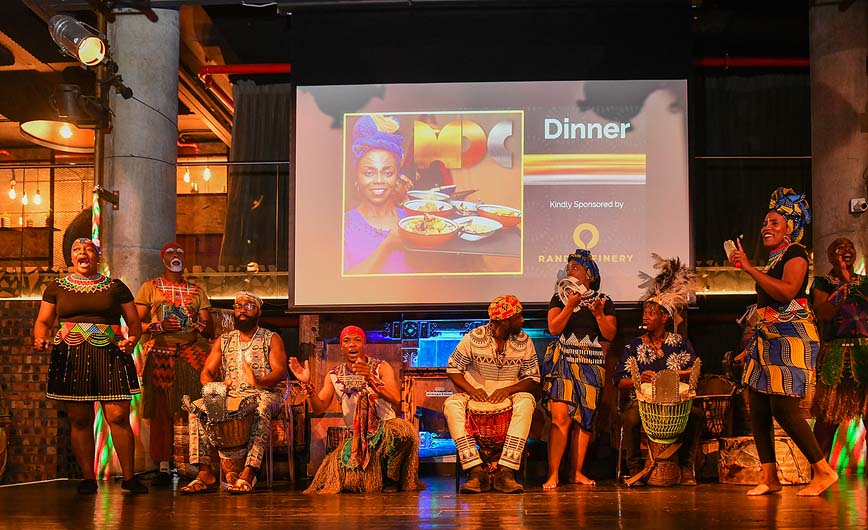



The 32nd Mint Directors Conference (MDC) took place from 27-29 April in Cape Town, South Africa. The event, co-hosted by the South African Mint Company, focused on exploring the fusion of traditional minting practices with modern technological advancements.
The MDC 2025 programme contained a range of sessions, including panel discussions on industry challenges, workshops on innovative techniques, and an awards ceremony recognising excellence in coin design and packaging.
The opening address was provided by South African Reserve Bank’s Executive Director Pradeep Maharaj, who welcomed the delegates to the conference, commenting that the event was ‘a long time coming’ (the event had originally been scheduled to take place in April 2020, ie. just after the world went into lockdown).
‘The events of the last few years have fundamentally reshaped how we work, live, and lead, with the global minting landscape also evolving rapidly’, he said. ‘Coins have long been a trusted method of exchanging and storing value, in addition to their use as a unit of measure. We should ensure that we produce coins that tell unique stories for eternity.’
Mint Directors Association (MDA) Chair, Marie Lemay, set the scene by summarising the six decade history of the Mint Directors Conference. Growing from an informal group to a conference held every two years – with this year’s event welcoming over 230 delegates from 93 organisations and 31 countries – MDC offers a venue for collaboration and discussion within the industry.
The first keynote speech of the conference was delivered by Doug Vining, a futurist and technology strategist affiliated with FutureWorld. His presentation explored the challenges and opportunities presented by rapid technological advancements, including strategies and disruptive technologies that drive exponential change. He stressed the importance of strategic foresight in the face of accelerating technological change and described his work in encouraging organisations and individuals to anticipate future trends and adapt proactively to maintain relevance and competitiveness.
Session 2 focused on the current state of the industry, with the MDA’s Executive Director Mark Cartwright stating that the industry’s shared navigating a world where the global payments system is evolving at an unprecedented pace. This session’s presentations described how mints are responding to these rapid changes by listening to their citizens to better understand their preferences, attitudes, behaviours, and beliefs, about cash and coins.
The Royal Canadian Mint’s Michelle Richardson reported that 85% of Canadians still identify as cash or coin users, with 74% having no intention of going fully cashless. Citizens appreciate the privacy and control cash offers, with coins remaining a practical necessity for many, especially in small towns – symbolising financial reliability and accessibility.
Nicolas Dumont from Monnaie de Paris then provided insights into using cash surveys as a strategic communication asset, such as accentuating the unique benefits of cash – including budgeting or for understanding the value of money – framing cash as a symbol of trust and identity (with the national mint as a guardian and narratives around trust, privacy, and inclusivity. He also highlighted the enduring role of cash in daily life, with French surveys showing that cash remains the second most used payment method since 2020.
The South African Mint’s Pearl Kgalegi rounded off the session’s presentations with a view of the South African cash ecosystem and current coin landscape. 86.3% of businesses and 75.3% of households use cash for payments, with the majority surveyed saying it is used frequently or all of the time. She concluded that coins are more than just a form of payment, they are a lifeline for many South Africans, a symbol of heritage, and a vital part of the country’s economy. It remains important to ensure that coins (and cash) remain a viable option for all.
The session ended with a workshop exercise on global attitudes and behaviours towards cash and coin use. Delegates were divided into groups and presented with one of three sets of survey questions. Each group was asked to identify which questions were the most important to generate useful and relevant data, with questions such as ‘which of the following means of payment do you use on a day-to-day basis?’, ‘how often do you pay with coins?’, and ‘do you plan on going completely cashless?’. This was followed by a reflection on whether all sovereign mints should conduct regular surveys, and what the role of the MDA should be in coordinating data collection.
Poongsan Corporation’s Hyomoon Nam completed the morning’s presentations with an overview of the antimicrobial and antiviral properties of copper alloys for coin blanks , stating that these properties are essential for coins as they circulate through many hands and require durability, workability, and recyclability.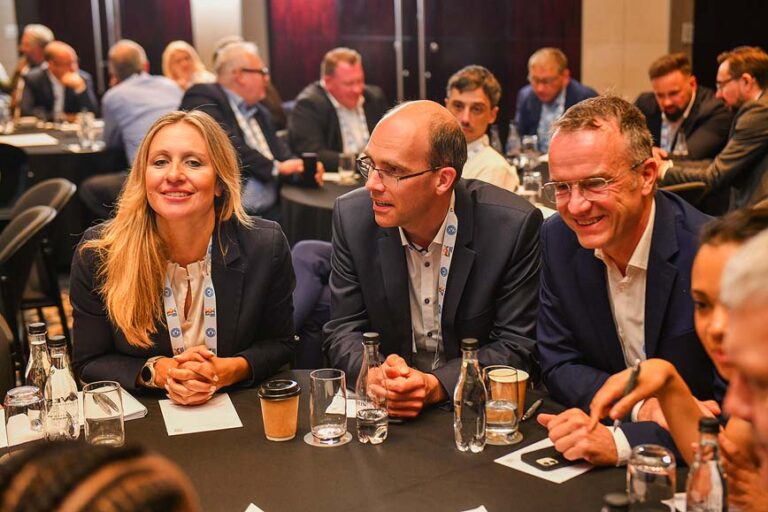
Day One’s afternoon sessions centred around a breakout session on home-grown innovation and sustainability and a panel session on carbon footprint reduction in the mint industry, respectively. The breakout session featured as part of a two-track programme, with the first of the IMD Technical Committee presentations (see below) taking place concurrently.
Kgomotso Lekola from BT Industrial Group described how knowledge gained during his investment with Africa Weather enabled him to identify a gap in the mining sector’s need for reliable HDPE pipes, which led him to founding BT Industrial Group – initially an engineering consultancy that later expanded into pipe manufacturing. Lekola committed to redefining Africa’s industrial landscape through innovation and sustainability, emphasising a reduction in the total cost of ownership while maximising return on investment for clients.
Next, Siya Xuza, founder and managing director of Galactic Energy Ventures, communicated how his work aims to provide affordable and reliable energy to underserved communities in Africa. Galactic Energy is an investment holding company focused on addressing the energy needs of emerging markets through innovative solutions. Xuza is focused on creating global opportunities by developing and investing in smart energy solutions tailored for these emerging markets.
The final session of Day One gave insights into how mints are reducing their carbon footprints from a strategic perspective, aligning sustainability with long-term goals, as well as practical steps to measure, manage, and reduce emissions effectively.
The Royal Mint’s Anne Jessopp opened the presentations by detailing the organisation’s comprehensive approach that spans all three emission scopes and which is built on a robust sustainability framework aligned with its business transformation strategy. She shared valuable lessons learnt during the sustainability journey, recommending that mints do not wait for perfect solutions and start their journey now, with communication and collaboration key to the process.
Tom Froggatt from the Royal Canadian Mint continued the theme of sustainable collaboration by presenting the Mint’s supplier engagement strategy. This includes its partnership with Agnico Eagle, which is recognised for its adherence to global sustainability standards, such as the Responsible Gold Mining Principles and the International Cyanide Management Code. The Mint’s 2024 Impact Report covers its Decarbonisation Roadmap, created to identify actions and investments aimed at reducing Scope 1 and Scope 2 greenhouse gas emissions, with a goal of a carbon-neutral circulation business by 2030.
Finally, delegates heard from Julie Grandjean about the Monnaie de Paris’ four pillar sustainable development strategy. This incorporates further contributions to the emergence of a low-carbon economy, with a 50% reduction in greenhouse gases by 2030, and an 80% reduction in non-recycled waste by 2027, coupled with a continuation of its search for new recycling channels. The Mint is also advancing its zero plastic policy, with a target of 0% non-recycled plastic in packaging by 2027, in addition to the intensification of its energy efficiency plan, aiming for a 30% reduction in energy consumption by 2027.
The IMD Technical Committee presentations took place as part of the two-track programme, running in parallel with the breakout session on home-grown innovation and sustainability and precious metals.
The Polish Mint’s Siemowit Kalukiewicz reported on the Committee’s project on automated coin and blank inspection, with participants including five mints and three industry partners. The project evaluated the capability of various systems to regulate the press force through visual inspections, aiming to do so in real time and at industrial volumes.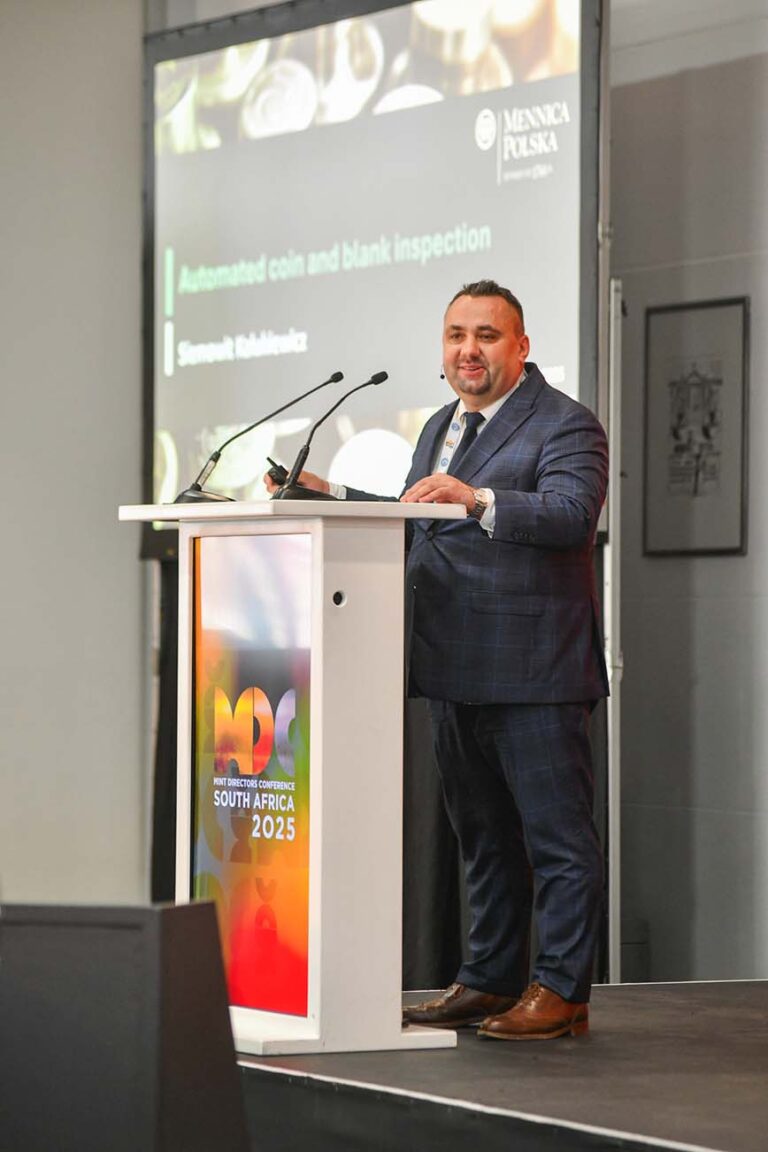
Next, Pascal Rencker of Monnaie de Paris presented the group’s work on tri-component coins, which envisions a tri-material, hybrid, smart coded coin suitable for circulation. Three versions of these coins have been explored – tri-metallic coins, two metals and one special polymer, and two metals and one ceramic feature – with the latter posing the greatest challenge for prototyping and potential mass production.
The US Mint’s Mike Costello continued the session by describing the Laser Subcommittee’s investigation into whether laser roughing and finishing can reduce die engraving time whilst maintaining each mint’s quality standard – and how this would impact the mints’ die production capabilities. Two new laser processes – ultra-fast engraving and performance toolpathing – utilised ACSYS Lasertechnik’s systems, with the mints involved achieving an average 78% reduction in time taken to produce a die.
The first technical breakout session finished with a presentation from Mathew Phillips of Crane Payment Innovations on a sensor sensitivity study on plated materials conducted by the EVA coin group and an IMD sub-committee. The study evaluated different substrates and plating combinations used in coins to determine the level of EMS (electromagnetic sensitivity) overlaps and assess if these can be reduced or avoided altogether. Recommendations for the industry include controlling the precision of plated layers, with wider variations in layer thickness resulting in less separation, and ensuring uniformed layer thickness on both sides of the coins, with different layer thicknesses on different sides also resulting in less separation.
Day Two followed the first set of breakout sessions, opening with the second keynote speech of the conference from Pontsho Maruping of the South African Radio Astronomy Observatory. The presentation covered the Square Kilometre Array project, which is an international effort to build the world’s largest radio telescope by harnessing cutting-edge technology and collaboration between countries. Pontsho highlighted benefits to the local community in terms of the creation of high-tech jobs, development of local skills in engineering and data science, infrastructure improvements, and economic gains through investment and local partnerships. The lessons learnt from the project can also be seen in the minting industry, in terms of the precision engineering and materials science required, in addition to sovereign infrastructure and development of a STEM (Science, Technology, Engineering, Mathematics) skilled workforce.
The second technical breakout session continued the conference programme, opening with a presentation on benchmarking in the minting industry. The presentation covered KPI benchmarking from the Austrian Mint’s Manfred Matzinger-Leopold , technical benchmarking from the Bavarian State Mint’s Reinhard Riffel, supplier benchmarking from Alfred Wertli’s Patrick Gimmi, and quality benchmarking from Andritz Schuler’s Dieter Merkle.
The topic closed with a note on external benchmarking, holding the objective of learning from other industries via company visits, with the last external benchmarking taking place in 2019 at the papermill of banknote substrate producers Louisenthal.
Next, Spaleck’s Ingo Löken presented an update on coin blank burnishing guidelines, which involved a strategy to increase sustainability and implement trial learnings into the Burnishing Handbook. The approach included the ‘3Rs’ – reduce (water, time, chemicals), replace (strong chemicals with mild chemicals, meaning chemical energy further assisted by mechanical energy), and recycle (water to be reused in the finishing process).
Dieter Merkle then discussed quality assurance for circulation coins, offering updated guidelines for characteristic features of plated or clad blanks and coins. The project considered the trend of switching from solid alloy to plated structures – due to seigniorage concerns, rising cost pressures, the replacement of materials for coins blanks, and new plating and cladding technologies. As an example, the updated guidelines include details about how the quality of the plated and clad structures can impact coin authentication.
The Royal Canadian Mint’s Xianyao Li closed the session with a summary of global counterfeiting issues and best practices for approaching coin security and anticounterfeiting measures.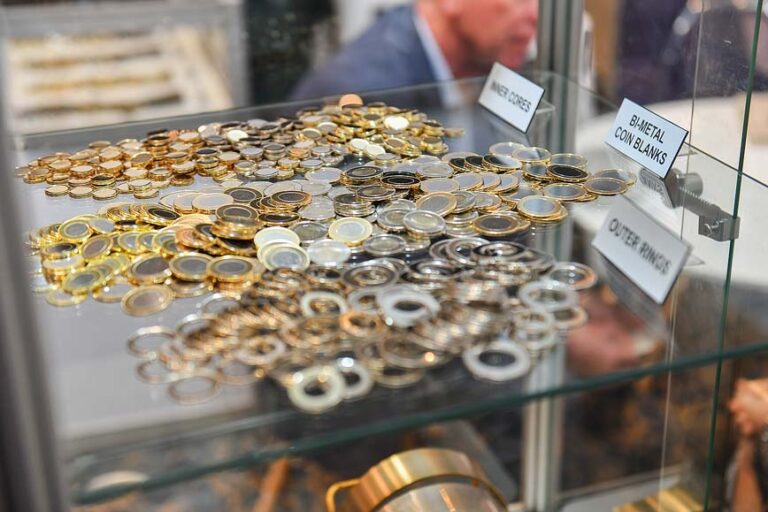
As mentioned above, a session on precious metals ran in tandem with the second technical breakout session, with the three presenters outlining the role of refineries and distributors as well as the current global bullion market.
The Rand Refinery’s Dean Subramanian detailed the refiners’ role in the product ecosystem, with international accreditation from institutions such as the London Bullion Market Association (LBMA) assisting the company in collaborating on risk management across the value chain, adding value, and monetising precious metals.
Richard Collocott from Prestige Bullion then detailed his company’s role as a joint venture between the South African Mint and Rand Refinery, established to enhance South Africa’s presence in the global bullion market. The joint venture combines the Mint’s expertise in coin production with the Refinery’s capabilities in precious metal refining and distribution. The primary bullion coin market has been impacted by an oversupply of secondary coins caused by profit taking, positive interest rates and volatile lease rates, increasingly complex global supply chains, and regulatory uncertainty, amongst other factors. Tough trading conditions are therefore expected for the short to medium term.
Dillon Gage’s Terry Hanlon completed the session with an overview of wholesale processes, with the company operating across multiple facets of the precious metals industry, such as trading, refining, secure storage, and technology services. New artificial intelligence (AI) technology is being used to enhance the company’s portfolio, providing predictive analytics for market forecasting and customer patterns, optimising the supply chain, and increasing operational efficiency.
The penultimate session of the conference explored the current and potential future use of AI in the minting industry.
Carveco’s Robert Newman opened the discussion by citing a number of use cases, both internally – including for software development and marketing – and for products, such as the company’s current project to utilise AI to process a ‘memory’ or photograph into a physical representation with 3D relief for the visually impaired. He underlined that data is key to the use of AI, and that business changes and new products must have a purpose – with the current project intentionally created in partnership with the visually impaired community.
Cameron Barnsley from Giesecke+Devrient continued the conversation with an expansion on AI’s ability to unlock new abilities across the company’s portfolio – with a new assistant, ‘Genie’, aiding in increased accessibility to its data analytics platform. AI provides the ability to handle large data sets easily, detecting seasonality and trends, and continually learning from this incoming data to enable greater accuracy in predicting cash trends.
The Royal Canadian Mint’s Marie Lemay completed the session presentations by providing an overview of how it has embraced AI, with small projects currently in place in every sector of the organisation. The Mint has a policy of encouraging employees to understand and make use of this new technology as much as possible, emphasising that the use of AI is a value added technology not an opportunity for employee replacement.
Robert Newman closed the session by demonstrating the abilities of individual and specific GPTs, (Generative Pre-Trained Transformers, a form of advanced open-source language model such as ChatGPT). He asked the AI assistant for a key takeaway from the session – which it noted as ‘AI is not about replacing creativity or human insight, it is about amplifying it’.
The final session of MDC 2025 featured a panel discussion on the main insights from the event, with Tom Power (Sunshine Minting), Marc Schwartz (Monnaie de Paris), Fokko Knol (Modern Numismatics International), Marie Lemay, Anne Jessopp, and Isabel Valldecabres Ortiz (FNMT-RCM, the Spanish Mint) discussing key takeaways from the conference session. These included safeguarding cash as a trusted and reliable method of payment, embracing future technologies and AI to assist in future planning, remaining agile and innovating to ensure that mints do not stand still, and the importance of data insights and collaboration.
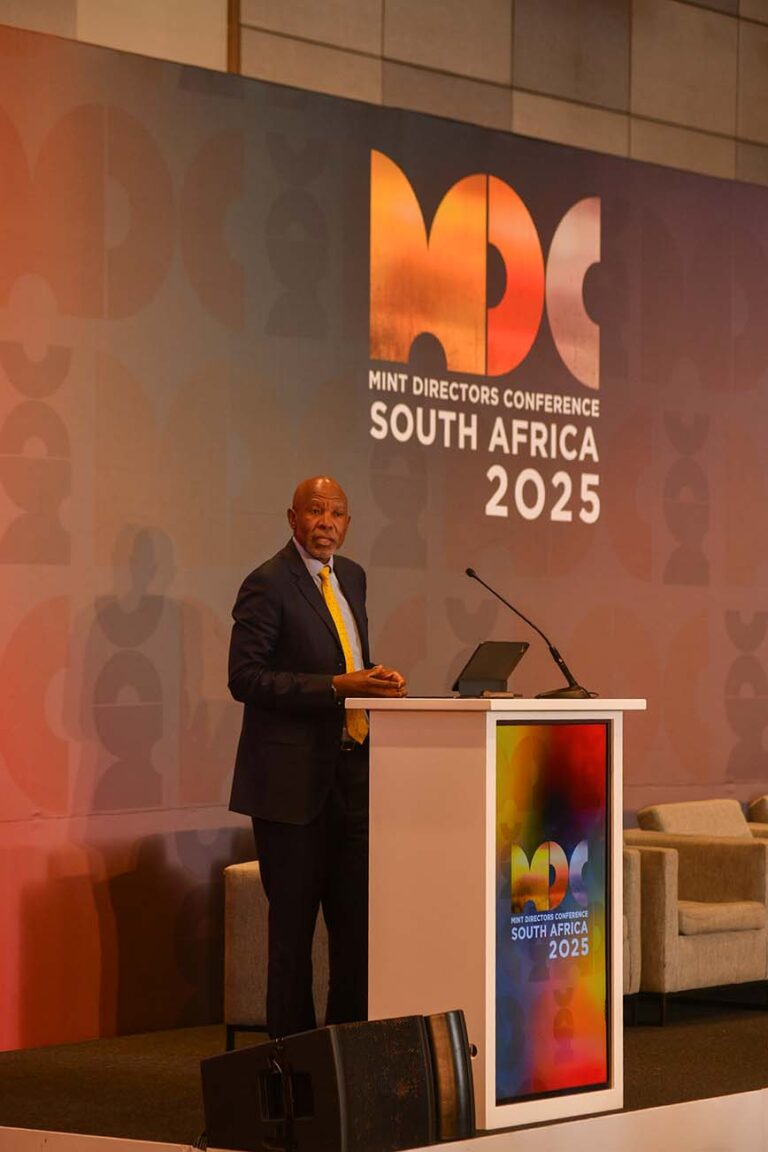 Governor Lesetja Kganyago of the South African Reserve Bank.Governor Lesetja Kganyago of the South African Reserve Bank closed the programme by highlighting the continuing vibrance of the coin minting industry, even as global manufacturing has declined. He noted the critical issues examined during the conference, in particular the continuing importance of coins, adoption of new technologies such as digital payments and AI – with the latter an opportunity to evolve traditional coin production – and sustainability.
Governor Lesetja Kganyago of the South African Reserve Bank.Governor Lesetja Kganyago of the South African Reserve Bank closed the programme by highlighting the continuing vibrance of the coin minting industry, even as global manufacturing has declined. He noted the critical issues examined during the conference, in particular the continuing importance of coins, adoption of new technologies such as digital payments and AI – with the latter an opportunity to evolve traditional coin production – and sustainability.
In addition to the main conference programme, several social events provided delegates with the opportunity to meet and engage with colleagues in a more relaxed setting, in addition to experiencing Cape Town’s scenery and culture. A welcome reception held at the V&A Waterfront’s Life Grand Café opened the MDC on Sunday evening, followed by an immersive African experience at GOLD Restaurant – complete with face painting, singing and dancing, traditional Mali puppets, and a multi-dish ‘taste safari’ – on the Monday evening.
Tuesday’s Gala Dinner offered a scenic route towards the event location, with delegates stopping along Chapman’s Peak Drive to view the sun setting over the water. Held at Cape Point Vineyards, the dinner included the much anticipated MDC Coin Awards..
MDC 2025 concluded with the handover to the next host country, Spain. The next MDC is scheduled to be held in April 2027 in Madrid.